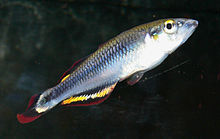Bedotia
| Bedotia | ||||||||||||
|---|---|---|---|---|---|---|---|---|---|---|---|---|

Undescribed Bedotia species " Ranomafana " |
||||||||||||
| Systematics | ||||||||||||
|
||||||||||||
| Scientific name | ||||||||||||
| Bedotia | ||||||||||||
| Regan , 1903 |
Bedotia is a genus offish endemic to Madagascar . A total of 16 different species are known, of which only nine have been formally described . The genus is native to the river basins of the east coast of Madagascar from Masihanaka in the south to Mahanara in the north. The animals live mainly in clearstreams and smaller rivers shadedby the tropical rainforest . They colonize an area from sea level to about 700 meters above sea level. The generic name honors the Swiss hydrobiologist Maurice Bedot .
Appearance
Bedotia can reach a standard length of 15 centimeters, but usually stay smaller. The elongated body is flattened on the sides and covered with large cycloid scales. Two to three rows of delicate, recurved, conical teeth sit on the easily protruding jaws. In large specimens, the palate and ploughshare are also toothed in one row. The ten to 13 branchiospins on the first gill arch are short, strong and toothed. Bedotia have two dorsal fins , the first of which is supported by five to six weak hard rays, the second by a weak hard ray and 10 to 14 divided soft rays. A hard ray and 16 to 20 split soft rays support the anal fin . The caudal fin is slightly notched, rounded or three-lobed. All species show a distinct sexual dimorphism , the adult males are larger, more colorful and have more noticeable unpaired fins than their female counterparts.
Way of life
All species are carnivorous . Approaching food, i.e. insects that have fallen into the water, forms the greater part of the food spectrum. To a lesser extent, aquatic invertebrates are also eaten. Field observations by B. nov. sp. "Garassa" showed a rather violent advertisement in which the male with his fins raised often swims in front of the female and then withdraws again. If the pairing is successful, the partners press their abdominal sides side by side in an S-shaped curve on the floor for one to two seconds. One or two eggs are laid with intense tremors. The act is repeated several times, but without the male introductory ritual. In an aquarium with a good supply of food, a female can shed several dozen eggs. The breeding season lasts the entire southern summer . Depending on the water temperature, the larvae hatch after ten to 14 days. Little is known about growth under natural living conditions; in captivity, Bedotia reach sexual maturity at around six to eight months of age.
species
The genus is monophyletic .
- Bedotia albomarginata Sparks & Rush, 2005
- Bedotia alveyi Johnes, Smith & Sparks, 2010
- Bedotia geayi Pellegrin, 1907
- Bedotia leucopteron Loiselle & Rodriguez, 2007
- Bedotia longianalis Pellegrin, 1914
- Bedotia madagascariensis Regan, 1903
- Bedotia marojejy Stiassny & Harrison, 2000
- Bedotia masoala Sparks, 2001
- Bedotia tricolor Pellegrin, 1932
status
The vast majority of Bedotia is classified by the IUCN as "endangered" ("vulnerable") or even "threatened with extinction" ("critically endangered"). A high pressure on the Bedotia populations practicing invasive species from either readjust the native species and compete with them for space, such as snakeheads and Livebearers . In the long term, however, the continued destruction of habitats through the deforestation of the rainforest and the associated disruption of the water balance is more serious.
Importance to humans
Despite their small size, Bedotia are also fished. Malagasy women catch the animals with woven baskets as part of small-scale fishing and subsistence farming . Several species are used as aquarium fish , but when B. madagascariensis was first introduced by Jacques Arnoult in 1953, this species was incorrectly identified as B. geayi and found its way into aquaristics under this name.
supporting documents
- ^ A b Paul Loiselle, Damaris Rodriguez: A new species of Bedotia (Teleostei: Atherinomorpha: Bedotiidae) from the Rianila drainage of Eastern Madagascar, with redescriptions of Bedotia madagascariensis and Bedotia geayi . In: Zootaxa . No. 1520, 2007, ISSN 1175-5326 (print) ISSN 1175-5334 (online), p. 2 ( PDF, 390 kB )
- ↑ Christophe Mailliet, Aleksei Saunders: Madagascar Rainbowfish - Notes on some recently discovered Bedotia species . Fishes of Sahul, 2005, Vol. 19 no. 2, 126-134 ( online )
- ^ A b Steven M. Goodman, Jonathan P. Benstead: The Natural History of Madagascar. The University of Chicago Press, Chicago 2003, ISBN 0-226-30306-3 . P. 867.
- ^ Peter Schubert: Bedotia. In: Claus Schaefer, Torsten Schröer (Hrsg.): The large lexicon of aquaristics. Eugen Ulmer, Stuttgart 2004, ISBN 3-8001-7497-9 , p. 140.
- ^ A b John S. Sparks , W. Leo Smith: Phylogeny and biogeography of the Malagasy and Australasian rainbowfishes (Teleostei: Melanotaenioidei): Gondwanan vicariance and evolution in freshwater in Molecular Phylogenetics and Evolution . No. 33, 2004, doi : 10.1016 / j.ympev.2004.07.002 . P. 729 ( PDF, 818 KiB )
- ↑ a b c d Goodman, Benstead p. 868
- ↑ Jones, Smith, Sparks: A New Species of Rainbowfish (Teleostei: Melanotaenioidei: Bedotiidae) from the Makira Region of Northeastern Madagascar . In: Copeia , 2010 (2), 284-291
- ↑ Species list at the IUCN
- ^ PN Reinthal, MLJ Stiassny: The Freshwater Fishes of Madagascar: A Study of an Endangered Fauna with Recommendations for a Conservation Strategy in Conservation Biology. Volume 5, No. 2, 1991, ISSN 0888-8892 . Pp. 238,239
- ↑ Loiselle, Rodriguez p. 7
Web links
- Bedotia on Fishbase.org (English)

